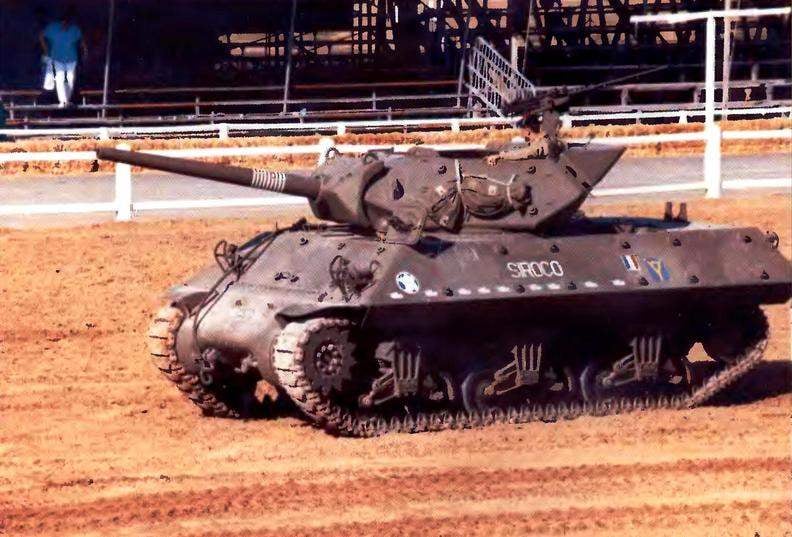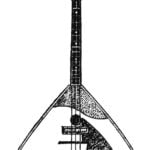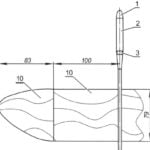 Simultaneously with the design, testing and deployment of serial production of light anti-tank self-propelled artillery installations (SAU) on the chassis of cars and armored personnel carriers (see “modelist-Konstruktor” No. 1, 2002) in the United States began to create similar military vehicles on tank chassis. In September 1941, the weapons Department was issued an order for the installation of the ACS 3-inch antiaircraft gun M3.
Simultaneously with the design, testing and deployment of serial production of light anti-tank self-propelled artillery installations (SAU) on the chassis of cars and armored personnel carriers (see “modelist-Konstruktor” No. 1, 2002) in the United States began to create similar military vehicles on tank chassis. In September 1941, the weapons Department was issued an order for the installation of the ACS 3-inch antiaircraft gun M3. A month later the project was approved and received the designation t-24. Self-propelled installation was made in early November at the plant of the Baldwin Locomotive Works and handed over for testing at the Aberdeen proving ground.
The establishment of this self-propelled nothing sverhvydayuschegosya Americans to invent did not. With the hull removed along with the tower turret sheet, eliminated the side sponson and machine guns coursework. As a result, in the formed open top armored cabin mounted anti-aircraft gun on a regular machine. And the barrel of the weapon passed over the frontal leaf cuttings. Sector horizontal fire was 33°, the vertical ranged from -2° to +15°. Tests showed that ACS was stable when firing at all aiming angles, both vertically and horizontally. Together with the experts of the landfill attributed to the significant disadvantages of a large machine height and unprotected calculation. In January 1942, the weapon was reassembled and the car was returned to the factory for rework in ACS T40.
For the last 3-inch antiaircraft guns М1918 already placed in the embrasure of a frontal leaf cuttings, lowering the height of the line of fire and virtually reducing to zero the horizontal sector of fire. Protection of members of the gun crew was significantly better, though the cabin and is open at the top. Testing of the ACS began in March 1942, according to their results, the machine was recommended to adopt. In April 1942, it was standardized under the designation M9. However, serial production of this SPG was never deployed. It was found that in the presence of the warehouses has a total of 27 anti-aircraft guns М1918!
Releasing such a small number of fighters of tanks didn’t solve the problem of equipping their ground forces. In August 1942, the project was closed, the more that work to create other fighter tanks ended where a great success.
We are talking about tank destroyers Kzt35. Her drawings of the Department of arms gave on 12 November 1941. The car was based on the chassis of the medium tank M4A1. 3-inch gun T12, borrowed from a heavy tank M6, mounted in the open top and back tower. The military was particularly attracted to this project, the possibility of firing through 360° and the use of standard tower overhead. In December, the basic chassis was replaced by M4A2 and produced a wooden mock-up of the ACS in full size. Soon the car was assembled in metal. The body of the tank M4A2 has undergone some changes. In particular, it has been eliminated to install exchange machine gun, and the thickness of the boards is reduced to 25.4 mm (1 inch). Armor drivetrain reinforced plate of the two plates, welded at a 90° angle. The gun was mounted in an open top welded round tower.
In the midst of work on Kzt35 the headquarters of the anti-tank units of the army of the United States put forward new requirements for self-propelled gun. Now she had to have a lower profile and sloped armor of the sides of the turret boxes. After making these changes the car has received index Т35Е1. In January 1942, at the factory of the company Fisher was made a prototype, which in the spring was transferred to Aberdeen proving ground for joint tests with Kzt35. The test firing demonstrated the advantage of the sloping armor of the hull, but the design of the tower acknowledged to be unsatisfactory. It was decided to replace it with a new hex, welded from rolled armor plates. In may 1942, after successful tests Т35Е1 recommended for serial production. In preparation for his design of the machine made some changes. In particular, once again reduced the thickness of the armor plates, supplied by the boarding hatch of the assistant of the driver and put on the armor hull and turret Bonki for fastening sheets of extra armor. In this form, in June 1942, the machine was standardized under the designation M10 or, to be absolutely accurate, the 3 inch Motor Gun Carriadge M10 (literally — “a motor carriage for 3-inch gun”).

Tank destroyer M10.
With serial production of the “motor wagon” was released late. She was associated with the design of the hexagonal tower. What kind of difficulties arose during its creation, the American sources are not reported. Honestly, it’s hard to believe they were technical in nature. In order not to delay the start of serial production, was developed by a temporary five-sided tower. However, as we know, there is nothing more permanent than temporary. When all the problems hex tower Rastrelli, its production just decided not to start.
The finished tank destroyer, the M10 was somewhat reminded of “Sherman” M4A2 chassis which it was created. The car had a welded hull, differing from the tank lower height and sloping location of the boards. In an open top rotating welded pentahedral tower was placed a 3-inch gun M7, developed on the basis of anti-aircraft. Length of the gun barrel was 50 calibers, the initial velocity armor — piercing projectile- 793 m/s In the rear of the turret to the swivel bracket mounted 12.7 mm anti-aircraft machine gun Browning М2НВ. The ammunition consisted of 54 artistree and 1000 cartridges.
The M10 tank destroyers were equipped with powertrain GMC model 6046 71 of the two 6-cylinder two-stroke natural pressure inline diesel engines arranged in parallel and connected in one unit with a capacity of 375 HP at 2100 rpm.
The transmission consisted of two single-disc main clutch dry friction (one per engine), the cross coupling transmission, propeller shaft, manual five-speed (5+1) gearbox with synchronizers on all gears except 1st and reverse, dual differential type “Cletrac” carrying out the role of the rotation mechanism, and single stage final drives.
Suspension, in relation to a Board, consisted of six single rubber-coated rollers are connected in pairs in three tandem suspended on two vertical buffer springs each; three support rollers, guide wheel drive wheel front location with a removable ring gear (cycloid gear). In each track there were 79 dvuhgrivnevka Shoe width 420,6 mm, step truck — 152 mm. Tracks are metal or rubber silent-block.
The level of armor protection ACS significantly decreased compared to the base tank. Thus, the frontal part of the body had a thickness of 50.8 mm, sides and stern — 25.4 mm, the roof is 9.5… 19 bottom — 12.7 mm. the thickness of the sheets of the tower — 25.4 mm. the Us military believed that a tank destroyer must have a higher mobility characteristics than a tank, albeit at the expense of security. However, a lot have been able to lower by about 2.5 tons, which had practically no impact on maneuverability. Of M10 tank destroyers in combat weight of 29.6 t developed the same maximum speed as a tank M4A2 — 48 km/h range thanks to a slightly larger fuel capacity was 320 km (tank — 290 km). The ACS crew consisted of five people.
In September 1942, at the Fisher plant began mass production of the M10 tank destroyers. During this month shop left the first 105 cars.
The release of the M10 was not until December of 1943 and ended with the manufacture 4993 self-propelled guns. In October 1943, production of the M10 and joined the Ford Motor firm. The company released “Sherman” versions М4АЗ, differing from the M4A2 mainly by type of power plant. The Ford version of the ACS, the designation М10А1, equipped with 8-cylinder Ford GAA engine power of 500 HP at 2600 rpm.

Tank destroyer M36 in the military Museum at Aberdeen proving ground in USA.
М10А1 Assembly on the production line Ford was carried out from October 1942 to September 1943 and ended after manufacture 1038 machines. In September of the same year, the Assembly М10А1 handed over to the factory to Fisher, where she continued in parallel with the M10 until the end of November 1943, and then in January 1944. Here collected 375 complete self-propelled guns and 300 without towers. The latter was used later in the manufacture of tank destroyers M36. Including these 300 machines, the total production amounted to М10А1 1713 units.
During serial production vehicle is improved very slightly. One has only to note the introduction of the sighting system of the machine, in addition to the telescopic sight, panoramas, and quadrant, which allowed ACS to fire from concealed positions.
Another problem was the instability of the tower occurred because of the placement in the front of heavy artillery systems (mass cannon was 911 kg). Solve it by placing in the rear of the turret part of the ammunition, antiaircraft machine gun and hitch spare truck failed. Had to use two feed leaves the tower special counterweight. As a result, the machine had to carry 1.6 tons of useless cargo. On the M10 was used four options balances, differing from each other form. In the latest version in the upper part of the counterweight was provided niches for placing items of ammunition and equipment.
Baptism M10 received as part of the 2nd army corps during the fighting in Tunisia in March 1943. Until the end of the war they were used in the fighting in Italy and on the Western front.
The program lend-lease the allies gave almost a third of the ACS M10 — 2143 machine. Of these, the UK received 1648, France and the Soviet Union 443 — 52.
In the US army these ACS were used before, and in the French army until the mid 1950-ies.
As for the red Army, the M10 units were equipped with two self-propelled artillery regiment. 1239-th self-propelled artillery regiment fought in the 16th tank corps, 2nd tank army of 1st Byelorussian front. He participated in the liberation of Belarus and Poland. 1223-th self-propelled artillery regiment as part of the 29th tank corps 5th guards tank army of the 3rd Belorussian front participated in the operations for liberation of Belarus, the Baltic States and East Prussia. On may 1, 1945, the regiment had 10 M10 tank destroyers, of which, however, only four were serviceable.
The M10 tank destroyer was the most massive American self-propelled guns in the British army. However, the British were not satisfied, in General, mediocre ballistic performance of a gun M7. And this at a time when they had a great 17-pound (76.2-mm) anti-tank gun, which they in anticipation of landing on the European continent sought to equip the largest possible number of combat vehicles.
From February 1944 on several arsenals began upgrading the M10. The work went quickly — the 17-pounder gun was well balanced, light barrel and compact, but heavy in the breech allowed to place it in the axles of the old guns. Gun ammunition consisted of 50 shots. Armor-piercing projectiles with armor-piercing ballistic tip and had an initial speed of 908 m/s From a distance of 900 meters this projectile pierced the armor plate thickness of 130 mm, angled 30° to the vertical. From August 1944 the ammunition also included, though in limited quantities, the new piercing projectiles APDS or SVDS. The mass of the projectile was 3,588 kg, mass of the tungsten core — 2,495 kg Projectile leaves the barrel at a speed of 1200 m/s and at a distance of 900 m punched 193-mm armor plate placed at an angle of 30° to the vertical. In General, the 17 pounder gun had some of the best characteristics of armor penetration than the German 88 mm KwK 36 and the American 90 mm caliber, and markedly inferior to only 88 mm cannon KwK 43 heavy tank “Royal tiger”.
Self-propelled M10 had in the British army two designations: SP 3 inch M10 Mk I (without counterweight in the tower) and 3 inch M10 SP Mk II (with a counterweight on the turret). More often, however, used the name Wolverine (“Wolverine”). ACS, armed with 17-pounder gun, was the index SP M10 17 pdr and the name Achilles (akhilles).
In the British army self-propelled gun M10 and Achilles went into service anti-tank artillery regiments of armored divisions and of corps and army artillery regiment. The troops of the 21st army group of field Marshal Montgomery during the battle of Normandy, there were 11 (8 British, 2 canadian and 1 Polish) self-propelled anti-tank regiments of artillery equipped with ACS “Achilles,” and a total of 270 military vehicles. The greater part of the self-propelled guns of this type joined the British army, fought in Italy.
As part of the Polish forces in the West during the period 1943 to 1945 was formed by four regiments of self-propelled artillery, armed ACS M10 and Achilles. Two of them took an active part in the hostilities.
Armed with the British army ACS “Achilles” were till mid 1950-ies. A significant number of self-propelled guns were transferred to other countries: Belgium, Denmark, Canada, Israel, South Africa and Italy.


Tank destroyer “Achilles”:
1 — 17-pounder gun; 2—muzzle brake; 3—a counterweight to the gun; 4—anti-aircraft machine gun Browning М2НВ; 5—opposed the tower; 6—driver’s hatch; 7—surveillance device amekhanika-driver; 8—hatch assistant of the driver; 9—the commander’s seat; 10—seat charging; 11—styling 17-pounder rounds; 12—seat gunner; 13—ring; 14—replacement truck; 15—a fire extinguisher; 16—an arm of fastening of a gun barrel travelling.
Weakness of arms its primary anti-tank self-propelled guns were aware and the Americans. They began to look for ways of its gain in 1942. Based on 90-mm anti-aircraft gun was created by a tank, however, all attempts to place it in the standard M10 turret failed. In March 1943, the firm Chevrolet introduced the project documents and a wooden model of the new tower. Soon, Ford has produced two prototypes of the new ACS on the chassis М10А1. Under the index T71 they received for testing at Aberdeen proving ground.
In July 1944, the machine was standardized under the designation M36. The first order for the production batch of self-propelled guns was issued in late 1943. Was actually manufactured only towers with weapons and chassis borrowed from self-propelled guns М10А1, and then the M10. From November 1943 to September 1945 thus produced 2324 machines three modifications.
By tampering with the chassis М10А1 received 1413 ACS M36. In the open top of the tower of cylindrical shape with a developed stern alcove, passing in contrast was 90-mm gun M3. Her ammunition consisted of 47 shots. Part of the guns were supplied with a muzzle brake.
On the basis of medium tank М4АЗ produced 187 self-propelled guns. Since the tower straps, M10 tank destroyers and tanks “Sherman” were the same, and a tower with 90-mm cannon mounted on a tank without any difficulty. This machine received the designation М36В1. However, it can be considered more of a modification of the tank, not self-propelled.
Finally, from March to September 1945, the factory shop left 724 ACS М36В2. These machines were manufactured on the chassis of the M10 and had a hinged armored roof over the crew compartment.
In August 1944, the first self-propelled M36 arrived in France. They were used mainly to combat the German heavy tanks and took an active part in repelling the German counteroffensive in the Ardennes in December 1944.
Until the beginning of 1950-ies M36 and М36В2 was in service with the us army and was used during the Korean war. These same machines were used by the French in Indochina until the mid-1950-ies. In the armies of countries such as Yugoslavia and Pakistan, they were much longer. The recent evidence of combat use of the M36 self-propelled guns belong to the time of the civil war in Yugoslavia 1991-1995.


The M10 tank destroyer during the show in a tank Museum in Samure, France. Photo by Steven Liens (USA)
M. BARYATINSKY



